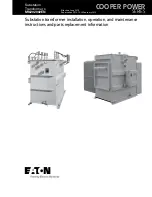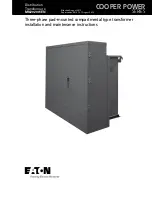
IMTX200H-03
www.ueonline.com
Re-Ranging
: Using the HART interface, the range of the TX200H can be
modified. This is useful in situations where the exact range transmitter is not
available. Re-Ranging is accomplished by changing the lower range value
and the upper range value to achieve the desired range. There are limita-
tions on the range adjustment. The lower/upper range limits must be within
the upper and lower sensor range (as marked on the transmitter body and
within the certificate of calibration) and the span must be greater that the
process variable (PV) minimum span programmed in the device. The PV min.
span is 10% of the range of the device for models with a pressure range of
≥ 100 psi and 20% of the range of the device for models with a pressure
range < 100 psi.
For example, a 1000 psi transmitter can be re-ranged to be a 100
psi transmitter.
Multi-Drop Mode
: Using HART communication it is possible to connect
up to 15 field devices to a HART master over a single pair of wires. In this
topology (see Figure 5) the field device is placed in a fixed current mode and
all communication occurs over the HART interface. Each device is assigned a
unique poll address (1-15). This serves as a unique address so that the
master can access the field devices individually.
NoTE
: The TX200H ships
from UE with the poll address set to O. A poll address of 0 indicates the
device is not in multi-drop mode.
Zone Hazardous Locations Flameproof
Gap and Joint Details
Electrical conduit fitting threaded connection: M20 x 1.5, 7 threads minimum
engagement.
Part II - Set-up
Tools Needed
HART Communicator or other Master
Using a HART handheld communicator, or other HART master,
you can access the many features of the TX200H.
Read Device Information
: you can read information such as the model
number and revision, the device I.D. and the range of the sensor.
Device Setup
: can be used to setup or commission a device prior to placing
it in service. These features allow the user to write things like a device tag
and a device description into the TX200H so that it can be uniquely identified
over the HART interface.
Basic/Detailed Setup Features Include:
1. Device Tag: The device tag identifies where the device will be
placed into service. A replacement device can be programmed to
have the same tag as the device it is replacing prior to installation.
2. Process Variable Units: Allows the user to select the units of mea-
sure (e.g., “wc, “Hg, psi, mbar, bar, kg/cm2, kPa, MPa).
3. Process Variable Limits: Allows the user to read the upper and
lower sensor limits and to read and adjust the upper and lower
range of the TX200H within the sensors limits and the allowable
turn-down range.
4. Device Description/Message: The user can program a text field that
reflects the function of the device.
5. Damping: The user can adjust the level of the damping applied to
the process variable. This feature is used to reduce the effect of
fluctuations in the readings. The value entered is the time constant
of the software filter, which adjusts the amount of damping.
Process Variables
: can be read over the HART interface. Pressure is the
primary variable. Temperature is the secondary variable.
NoTE
: Reported
temperature is the ambient temperature at the back of the sensor and not
the process media temperature.
•
Primary Variable: can be read in pressure units, percent of range or in mA.
•
Secondary Variable: Available in °F
Diagnostic and Service
: there are several TX200H diagnostic and service
features available over the HART interface.
1. Calibration: There are two ways to calibrate the TX200H.
a. If a calibrated pressure source is available, the user can apply a low
and high pressure and set the low and high range points.
b. If no pressure source is available, the user can manually enter values
for the upper range limit and the lower range limit.
2. D/A Trim: This feature allows the user to calibrate the D/A converter
that generates the 4-20mA signal. The output is first set to 4mA. The
user must measure and enter the loop current. The output is then set
to 20mA. The user again must measure and enter the loop current.
The output of the D/A is adjusted for offset and span.
3. Loop Test: The loop test feature forces the output current to a user
specified value. It can be set to 4mA, 20mA or to another value entered
by the user.
Figure 5
Red
Black
Red
Black
Red
Black
HART
Master
TX200H
#1
TX200H
#2
TX200H
#15
...
























